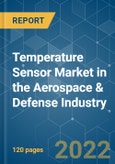The Temperature Sensors Market in the Aerospace & Defense Industry is expected to register a CAGR of approximately 9% during the forecast period (2021 - 2026). The adoption of process and monitoring automation in the industrial operations have been augmenting the demand for sensors for several applications, such as asset monitoring, security, and quality assurance.
Key Highlights
- Improved reliability of networked equipment with communication technology advancements is the significant factor driving the market for temperature sensors in the aerospace and defense industry. Substantial investments in the aerospace and defense industry to innovate and adopt new sensor technologies and the upgradation of existing infrastructure to support the adoption of IoT and automation in the industry are certain factors impacting the industry.
- In August 2019, CTS Corporation acquired the temperature sensor supplier Quality Thermistor, Inc. and broadened its product line. QTI Sensing Solutions supplies temperature sensors serving OEMs in the industrial, aerospace, defense, and medical markets. QTI’s sensors measure temperature in gas, liquid, or a solid mass, depending on the application, to ensure equipment performance and reliability.
- In May 2020, India’s state-owned Naval Dockyard in Mumbai developed a handheld infrared (IR)-based temperature gun sensor to screen a large number of people entering the dockyard daily to curb the spread of COVID-19 pandemic.
Key Market Trends
Thermocouple Sensors Expected to Exhibit Maximum Adoption
- The aerospace and defense industry has embraced digital transformation rapidly, which has stimulated the adoption of temperature sensors in the industry, due to the adoption of portable electronic devices and embedded electronics systems in the industry. These trends have significantly contributed to the increase in RF emissions, causing interference or data corruption.
- Thermocouple sensors are reliable and robust in nature and provide a fast temperature sensing solution, which is a preferred solution in many aerospace, defense, and security applications. These high-reliability sensors are suitable for harsh environments such as harsh temperatures, RFI, EMI, Vibration, and Lightning, and many more.
- Research and development activities in the field of temperature sensors are expected to increase the awareness about the thermocouple temperature sensor, which will subsequently increase its demand in industrial applications, such as aerospace and defense applications. For instance, a team of researchers at the University of Oxford, Delft University, and IBM Zurich have successfully demonstrated the usage of graphene to build sensitive and self-powering temperature sensors. The findings pave the way for the design of highly sensitive thermocouples, which could be integrated into nanodevices and even living cells.
North America Expected to Dominate the Market
- North America emerges as the priority choice for the market vendors in the market studied, as the region is highly benefitted by the presence of the critical infrastructure necessary for the solution. Also, the presence of temperature sensor manufacturers and system integrators in the region is expected to drive the growth in the market.
- In May 2020, Pentagon security deployed thermal cameras on tripods to check temperatures at the building’s Visitor Center since April. The REF worked with the Army’s C5ISR Center lab and Program Executive Officer, to convert infrared targeting sensors into hands-off thermometers to combat the COVID-19 coronavirus. The Pentagon Force Protection Agency wants to set up sensors at other points around the massive headquarters, including the entrance to the Washington Metro subway system.
- Also, in March 2020, Meggitt PLC, a provider of high-performance components and subsystems for the aerospace and defense, completed a five-year contract extension with GE Aviation for the supply of valves, sensors, and heat exchangers across a range of engine programs. The partnership is expected to act as a catalyst for the adoption of temperature sensors in the aerospace and defense industry in the region.
Competitive Landscape
The competitive landscape of the Temperature Sensor Market in the Aerospace and Defense Industry is expected to be fragmented owing to the presence of several global market players, such as Honeywell, Meggitt PLC, Sensata, TE Connectivity, and many more. The market players are making strategic partnerships and collaborations to boost their market presence.
- March 2020 - FLIR Systems, Inc. introduced the FLIR A400/A700 Thermal Smart Sensor, and Thermal Image Streaming fixed camera solutions for monitoring equipment, production lines, critical infrastructure, and screening for elevated skin temperatures. These highly configurable smart camera systems provide accurate, non-contact temperature monitoring across a wide range of disciplines, such as manufacturing process control, product development, emissions monitoring, waste management, facilities maintenance, and Environmental, Health, and Safety (EHS) improvements.
Additional Benefits:
- The market estimate (ME) sheet in Excel format
- 3 months of analyst support
This product will be delivered within 2 business days.
Table of Contents
Companies Mentioned (Partial List)
A selection of companies mentioned in this report includes, but is not limited to:
- Honeywell International Inc.
- Meggit PLC
- Sensata Technologies Inc.
- TE Connectivity Ltd.
- Conax Technologies
- TMI-USA Inc.
- Innovative Sensor Technology IST AG
- Emerson Electric Co.
- RdF Corporation
- Amphenol Advanced Sensors
- Littelfuse Inc.
Methodology

LOADING...








